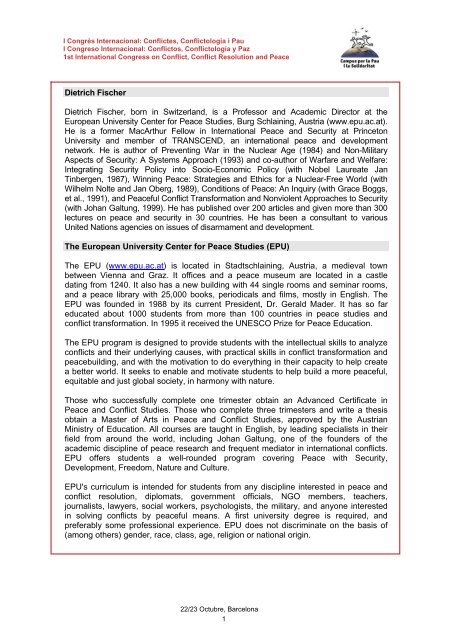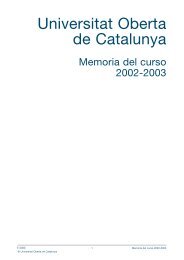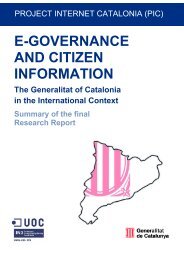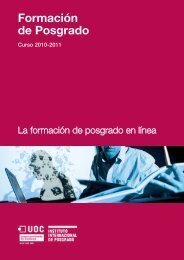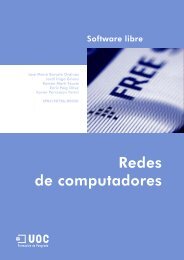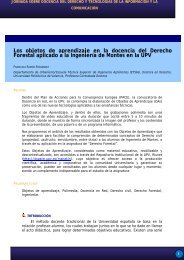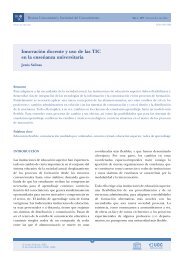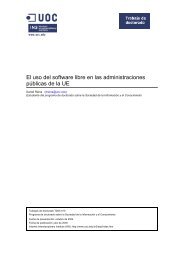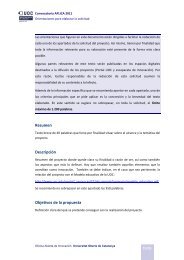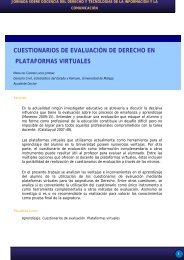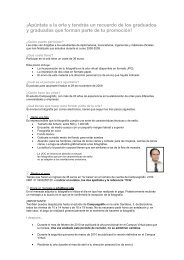Dietrich Fischer Dietrich Fischer, born in Switzerland, is a Professor ...
Dietrich Fischer Dietrich Fischer, born in Switzerland, is a Professor ...
Dietrich Fischer Dietrich Fischer, born in Switzerland, is a Professor ...
You also want an ePaper? Increase the reach of your titles
YUMPU automatically turns print PDFs into web optimized ePapers that Google loves.
I Congrés Internacional: Conflictes, Conflictologia i PauI Congreso Internacional: Conflictos, Conflictología y Paz1st International Congress on Conflict, Conflict Resolution and Peace<strong>Dietrich</strong> <strong>F<strong>is</strong>cher</strong><strong>Dietrich</strong> <strong>F<strong>is</strong>cher</strong>, <strong>born</strong> <strong>in</strong> <strong>Switzerland</strong>, <strong>is</strong> a <strong>Professor</strong> and Academic Director at theEuropean University Center for Peace Studies, Burg Schla<strong>in</strong><strong>in</strong>g, Austria (www.epu.ac.at).He <strong>is</strong> a former MacArthur Fellow <strong>in</strong> International Peace and Security at Pr<strong>in</strong>cetonUniversity and member of TRANSCEND, an <strong>in</strong>ternational peace and developmentnetwork. He <strong>is</strong> author of Prevent<strong>in</strong>g War <strong>in</strong> the Nuclear Age (1984) and Non-MilitaryAspects of Security: A Systems Approach (1993) and co-author of Warfare and Welfare:Integrat<strong>in</strong>g Security Policy <strong>in</strong>to Socio-Economic Policy (with Nobel Laureate JanT<strong>in</strong>bergen, 1987), W<strong>in</strong>n<strong>in</strong>g Peace: Strategies and Ethics for a Nuclear-Free World (withWilhelm Nolte and Jan Oberg, 1989), Conditions of Peace: An Inquiry (with Grace Boggs,et al., 1991), and Peaceful Conflict Transformation and Nonviolent Approaches to Security(with Johan Galtung, 1999). He has publ<strong>is</strong>hed over 200 articles and given more than 300lectures on peace and security <strong>in</strong> 30 countries. He has been a consultant to variousUnited Nations agencies on <strong>is</strong>sues of d<strong>is</strong>armament and development.The European University Center for Peace Studies (EPU)The EPU (www.epu.ac.at) <strong>is</strong> located <strong>in</strong> Stadtschla<strong>in</strong><strong>in</strong>g, Austria, a medieval townbetween Vienna and Graz. It offices and a peace museum are located <strong>in</strong> a castledat<strong>in</strong>g from 1240. It also has a new build<strong>in</strong>g with 44 s<strong>in</strong>gle rooms and sem<strong>in</strong>ar rooms,and a peace library with 25,000 books, periodicals and films, mostly <strong>in</strong> Engl<strong>is</strong>h. TheEPU was founded <strong>in</strong> 1988 by its current President, Dr. Gerald Mader. It has so fareducated about 1000 students from more than 100 countries <strong>in</strong> peace studies andconflict transformation. In 1995 it received the UNESCO Prize for Peace Education.The EPU program <strong>is</strong> designed to provide students with the <strong>in</strong>tellectual skills to analyzeconflicts and their underly<strong>in</strong>g causes, with practical skills <strong>in</strong> conflict transformation andpeacebuild<strong>in</strong>g, and with the motivation to do everyth<strong>in</strong>g <strong>in</strong> their capacity to help createa better world. It seeks to enable and motivate students to help build a more peaceful,equitable and just global society, <strong>in</strong> harmony with nature.Those who successfully complete one trimester obta<strong>in</strong> an Advanced Certificate <strong>in</strong>Peace and Conflict Studies. Those who complete three trimesters and write a thes<strong>is</strong>obta<strong>in</strong> a Master of Arts <strong>in</strong> Peace and Conflict Studies, approved by the AustrianM<strong>in</strong><strong>is</strong>try of Education. All courses are taught <strong>in</strong> Engl<strong>is</strong>h, by lead<strong>in</strong>g special<strong>is</strong>ts <strong>in</strong> theirfield from around the world, <strong>in</strong>clud<strong>in</strong>g Johan Galtung, one of the founders of theacademic d<strong>is</strong>cipl<strong>in</strong>e of peace research and frequent mediator <strong>in</strong> <strong>in</strong>ternational conflicts.EPU offers students a well-rounded program cover<strong>in</strong>g Peace with Security,Development, Freedom, Nature and Culture.EPU's curriculum <strong>is</strong> <strong>in</strong>tended for students from any d<strong>is</strong>cipl<strong>in</strong>e <strong>in</strong>terested <strong>in</strong> peace andconflict resolution, diplomats, government officials, NGO members, teachers,journal<strong>is</strong>ts, lawyers, social workers, psycholog<strong>is</strong>ts, the military, and anyone <strong>in</strong>terested<strong>in</strong> solv<strong>in</strong>g conflicts by peaceful means. A first university degree <strong>is</strong> required, andpreferably some professional experience. EPU does not d<strong>is</strong>crim<strong>in</strong>ate on the bas<strong>is</strong> of(among others) gender, race, class, age, religion or national orig<strong>in</strong>.22/23 Octubre, Barcelona1
I Congrés Internacional: Conflictes, Conflictologia i PauI Congreso Internacional: Conflictos, Conflictología y Paz1st International Congress on Conflict, Conflict Resolution and PeacePeace <strong>in</strong>cludes the absence of war, but it <strong>is</strong> much more. It <strong>is</strong> the absence of violence <strong>in</strong>all of its forms and the presence of mutually beneficial cooperation and mutual learn<strong>in</strong>g.Just as there <strong>is</strong> a d<strong>is</strong>t<strong>in</strong>ction between negative health (absence of d<strong>is</strong>ease) and positivehealth (the capacity to res<strong>is</strong>t d<strong>is</strong>ease) there <strong>is</strong> a d<strong>is</strong>t<strong>in</strong>ction between negative peace(absence of violence, and more particularly absence of war) and positive peace, thecapacity to conta<strong>in</strong> violence and to transform conflicts by peaceful means. The d<strong>is</strong>t<strong>in</strong>ctionbetween peace-keep<strong>in</strong>g and peace-build<strong>in</strong>g resembles the d<strong>is</strong>t<strong>in</strong>ction between curativeand preventive medic<strong>in</strong>e.Johan Galtung (<strong>in</strong> "The Com<strong>in</strong>g One Hundred Years of Peacemak<strong>in</strong>g: V<strong>is</strong>ions of Peacefor the 21st Century", a lecture given at the Centenary Conference of the InternationalPeace Bureau <strong>in</strong> Hels<strong>in</strong>ki on 30 August 1993) d<strong>is</strong>t<strong>in</strong>gu<strong>is</strong>hes between four forms ofpower: military, economic, political and cultural. They correspond to four basic humanneeds, for survival, economic well-be<strong>in</strong>g, freedom and identity (the opposites be<strong>in</strong>gdeath, m<strong>is</strong>ery, oppression and alienation). These lead to the d<strong>is</strong>t<strong>in</strong>ction between fourforms of violence: direct violence (hurt<strong>in</strong>g and kill<strong>in</strong>g people with weapons), structuralviolence I (the slow death from hunger, preventable d<strong>is</strong>eases and other suffer<strong>in</strong>g causedby unjust structures of society, which now kills over 100'000 people every day), structuralviolence II (deprivation from freedom of choice and from participation <strong>in</strong> dec<strong>is</strong>ions thataffect people's own lives), and cultural violence (the justification of direct and structuralviolence <strong>in</strong> education, the media, literature and art, <strong>in</strong> the form of national<strong>is</strong>m, rac<strong>is</strong>m,sex<strong>is</strong>m and other forms of d<strong>is</strong>crim<strong>in</strong>ation and prejudice).Peace has then eight components--the absence of these four forms of violence("negative peace"), and the presence of activities to br<strong>in</strong>g relief for past or presentviolence and to prevent future violence ("positive peace"), <strong>in</strong> their military, economic,political and cultural dimensions.The EPU Curriculum addresses all of these eight components of peace, with coursesl<strong>is</strong>ted <strong>in</strong> Table 1. The Masters program requires three trimesters of courses, last<strong>in</strong>g 12weeks each (fall, spr<strong>in</strong>g and summer). Courses <strong>in</strong> the fall trimester focus primarily ondirect violence and how to avoid it. Courses <strong>in</strong> the spr<strong>in</strong>g trimester focus ma<strong>in</strong>ly onstructural violence and ways to overcome it. Courses <strong>in</strong> the summer trimesterconcentrate on cultural violence and cultural peace. Some courses (e.g. Introduction toPeace Studies, Theories and Methodologies <strong>in</strong> Peace Studies, Game Theory,Management and Evaluation of Peace Projects, Strengthen<strong>in</strong>g the United NationsSystem, Professional<strong>is</strong>m <strong>in</strong> Peace Work, V<strong>is</strong>ion<strong>in</strong>g Peaceful Societies and PeacefulWorlds) relate to all aspects of peace and are therefore not l<strong>is</strong>ted <strong>in</strong> any particularcategory <strong>in</strong> Table 1.Table 1: Eight Components of Peace, and Courses Address<strong>in</strong>g ThemMilitaryNegative PeaceViolence, Security,D<strong>is</strong>armament;Terror<strong>is</strong>m and StateTerror<strong>is</strong>m: Causesand Prevention;Cr<strong>is</strong>es Prevention,Intervention,Reconciliation andReconstructionPositive PeaceConflict Transformation by Peaceful Means;Dialogue, Negotiation, Mediation and Arbitration;Nonviolence: From Philosophy to Practical Tool;Work<strong>in</strong>g for Peace <strong>in</strong> Conflict Zones; Unity BasedConflict Resolution; Peace and Social Movements;Transition from Civil War to Peace; NonmilitaryApproaches to Security; Conflict Mitigation22/23 Octubre, Barcelona3
I Congrés Internacional: Conflictes, Conflictologia i PauI Congreso Internacional: Conflictos, Conflictología y Paz1st International Congress on Conflict, Conflict Resolution and PeaceEconomicPoliticalCulturalThe Global Economyand Alternatives;Cop<strong>in</strong>g with Dangersto the EnvironmentHuman Rights; Goodand BadGovernance, withCase Studies fromAfricaCulture and Conflict;Global Mass Media,Information Warfareand CyberwarA Life-Susta<strong>in</strong><strong>in</strong>g Economy; Theories ofDevelopment; Peace and Bus<strong>in</strong>ess; A Theory ofPeace: Positive Peace and Development; HumanSecurity; Gender and Development; The HumanRight to Food and Nutrition; Conversion fromMilitary to Civilian ProductionGovernance and Participation; Community-BasedPeacebuild<strong>in</strong>g; The European Union as a PeaceForce; Global Civil Society and Global Governance;Democratization; International Law and WorldOrder; International Relations and the Search forPeace; Protection of M<strong>in</strong>orities and Self-Determ<strong>in</strong>ation; Research for Social JusticePeace Education; Culture and Communication;Basic Needs, Deep Structure and Deep Culture;Conflict Culture and Conciliation; Gender andCultures of Peace; Peace and Ethics; Peace andReligions; Peace Psychology; Utopias of Peace <strong>in</strong>Literature; Nonviolent Communication; Imag<strong>in</strong><strong>in</strong>gCultures of Peace; African Resources andObstacles for Peace; Facilitat<strong>in</strong>g Social Change:Conscientization and Mobilization forEmpowerment; Peace Journal<strong>is</strong>mDescriptions of these courses can be found at www.epu.ac.at.A total of 72 week-long courses are offered dur<strong>in</strong>g the three trimesters, meet<strong>in</strong>g 3 hoursevery day of the week, some <strong>in</strong> the morn<strong>in</strong>g, others <strong>in</strong> the afternoon. Students arerequired to take 36 courses for credit. They may audit additional courses if they w<strong>is</strong>h.Students also write a Master's thes<strong>is</strong>, usually after complet<strong>in</strong>g their course work.Different from most other universities, which have their fixed faculty, EPU has theflexibility to <strong>in</strong>vite the best teachers from around the world with<strong>in</strong> their respective specialfields. EPU's more than 50 v<strong>is</strong>it<strong>in</strong>g faculty members come from all cont<strong>in</strong>ents and from awide variety of d<strong>is</strong>cipl<strong>in</strong>es, with real life experience, offer<strong>in</strong>g a great variety <strong>in</strong>perspectives. As a practical demonstration of cultural peace, EPU seeks to achieve ageographical and gender balance <strong>in</strong> its teach<strong>in</strong>g faculty. Efforts are made to <strong>in</strong>cludewomen and lecturers from Africa, Asia and Lat<strong>in</strong> America.The courses equally emphasize theory, concrete illustrations, and practical exerc<strong>is</strong>es.The students are encouraged to exam<strong>in</strong>e what they have learnt from a personalviewpo<strong>in</strong>t to see what consequences emerge for their own v<strong>is</strong>ion, life and work. EPUseeks to tra<strong>in</strong> peace practitioners, not only theoreticians. Study<strong>in</strong>g about peace withoutapply<strong>in</strong>g it would be as irresponsible as if a doctor were to study sick patients withouthelp<strong>in</strong>g them to reduce their suffer<strong>in</strong>g.In addition to the courses and workshops taught, a valuable aspect of study<strong>in</strong>g at EPU <strong>is</strong>the immersion <strong>in</strong> the culture of a society at peace, and the opportunity to learn also fromdialogues with fellow students from around the world. Many alumni have said that thetime they spent at EPU was one of the best experiences <strong>in</strong> their lives. Th<strong>is</strong> has an effectbeyond mere book learn<strong>in</strong>g. It <strong>is</strong> remarkable, for example, that Alexander Yakovlev,Gorbachev's closest adv<strong>is</strong>er and the key architect of perestroika, was a member of the22/23 Octubre, Barcelona4
I Congrés Internacional: Conflictes, Conflictologia i PauI Congreso Internacional: Conflictos, Conflictología y Paz1st International Congress on Conflict, Conflict Resolution and Peacefirst delegation of thirty Soviet students who studied a year <strong>in</strong> the United States with aFulbright fellowship <strong>in</strong> 1958. The few thousand dollars for that scholarship did more toend the cold war than billions spent for weapons, which only exacerbated tensions.At a weekly sem<strong>in</strong>ar, students and faculty d<strong>is</strong>cuss and compare causes of war,escalation, efforts at mediation, and reconciliation <strong>in</strong> conflicts and wars <strong>in</strong> the South, Eastand West (especially <strong>in</strong> the Great Lakes region of Africa, <strong>in</strong> the Balkans, Middle East andCentral Asia, and <strong>in</strong> Northern Ireland and the Basque region of Spa<strong>in</strong>). The key question<strong>is</strong> how wars beg<strong>in</strong> and end. We are fortunate to have students from the South (Africa,Asia and Lat<strong>in</strong> America), as well as the East (Eastern Europe and former Soviet Union)and West (Western Europe and North America). Most of our students have alreadyseveral years of professional experience <strong>in</strong> governments, NGOs or bus<strong>in</strong>ess. That offersthe opportunity to draw on their personal experiences. New <strong>in</strong>sights often emerge whenpeople compare different experiences and approaches toward solutions of problems. Atthe beg<strong>in</strong>n<strong>in</strong>g of each sem<strong>in</strong>ar, one or more participants present a conflict with whichthey are particularly familiar, its causes, development, and attempted solutions (whethersuccessful or not) and efforts to achieve reconciliation. The d<strong>is</strong>cussions will not be limitedto violent conflicts, one can learn just as much from conflicts where violence was avoided<strong>in</strong> time, for example how a civil war was avoided by grant<strong>in</strong>g a m<strong>in</strong>ority the autonomy itdesired.In addition to attend<strong>in</strong>g courses, students get to know each other closely and concludefriendships for a lifetime. In summer of 2007, EPU had 50 students from 30 countriesfrom five cont<strong>in</strong>ents, about half from Africa, Asia and Lat<strong>in</strong> America. Many formerstudents said that study<strong>in</strong>g at EPU was the best time of their life. We are happy thatmany of our former students now have successful careers <strong>in</strong> <strong>in</strong>ternational organizations,NGOs, bus<strong>in</strong>esses, universities, or work with their governments.The MA program at EPU <strong>is</strong> designed to give a comprehensive overview over all aspectsof peace. It <strong>is</strong> our <strong>in</strong>tention to offer specialization <strong>in</strong> specific areas <strong>in</strong> a future doctoralprogram <strong>in</strong> peace studies.A L<strong>is</strong>t of Recommended LiteratureBarash, David, and Charles Webel (2002) Peace and Conflict Studies, SagePublications. A comprehensive <strong>in</strong>troductory textbook to peace studies.Chetkow-Yanoov, Benyam<strong>in</strong> (1996) Social Work Approaches to Conflict Resolution:Mak<strong>in</strong>g Fight<strong>in</strong>g Obsolete. B<strong>in</strong>ghamton, New York: The Haworth Press. A good<strong>in</strong>troduction with a wealth of personal experience.Curle, Adam (1995) Another Way: Positive Response to Contemporary Violence. Oxford:Jon Carpenter. Based on experience from India and Pak<strong>is</strong>tan, Nigeria, SouthAfrica, Zimbabwe, Ireland, Sri Lanka, Yugoslavia to mention some. Equallyrecommended <strong>is</strong> h<strong>is</strong> classic, Mak<strong>in</strong>g Peace (Tav<strong>is</strong>tock, 1971)<strong>F<strong>is</strong>cher</strong>, <strong>Dietrich</strong> (1993), Nonmilitary Aspects of Security: A Systems Approach.Aldershot: Dartmouth. Covers strategies for nonmilitary defense, development,protect<strong>in</strong>g the environment and human rights, at the <strong>in</strong>dividual, local, national andglobal level.22/23 Octubre, Barcelona5
I Congrés Internacional: Conflictes, Conflictologia i PauI Congreso Internacional: Conflictos, Conflictología y Paz1st International Congress on Conflict, Conflict Resolution and PeaceGaltung, Johan (2004) Transcend and Transform: An Introduction to Conflict Work.London: Pluto Press. Th<strong>is</strong> book presents a carefully developed theoreticalframework, the TRANSCEND approach, and illustrates it with numerous concretecases based on five decades of experience as mediator, rang<strong>in</strong>g from conflicts atthe personal to the global level.Galtung, Johan (2000) Conflict Transformation By Peaceful Means: the TRANSCENDApproach. Geneva: United Nations. 50 concrete lessons <strong>in</strong> practical conflicttransformation, with exerc<strong>is</strong>es for self-study. Available for free atwww.transcend.org, where literature on peace and conflict from many authors <strong>is</strong>posted for free download<strong>in</strong>g.Galtung, Johan (1996) Peace By Peaceful Means. Thousand Oaks, California, London,New Delhi: Sage Publications. A comprehensive and conc<strong>is</strong>e overview of PeaceTheories, Conflict Theories, Development Theories and Civilization Theories(roughly correspond<strong>in</strong>g to direct violence, conflict transformation, structuralviolence and cultural violence).Galtung, Johan (1984) There Are Alternatives! Four Roads to Peace and Security.Nott<strong>in</strong>gham: Spokesman. Covers neutrality, nonoffensive and nonmilitarydefense, domestic peace, and usefulness for others as national securitystrategies.Lederach, John Paul (1995) Prepar<strong>in</strong>g for Peace: Conflict Transformation AcrossCultures. Syracuse, New York: Syracuse Univ. Press. Based on the author'sextensive experience <strong>in</strong> Lat<strong>in</strong> America, Asia and Africa, and h<strong>is</strong> "elicitive"approach to understand the goals of the parties.Mitchell, Chr<strong>is</strong>topher and Banks, Michael (1996), Handbook of Conflict Resolution: TheAnalytical Problem-Solv<strong>in</strong>g Approach. London: P<strong>in</strong>ter. Focuses on br<strong>in</strong>g<strong>in</strong>gconflict parties together for a jo<strong>in</strong>t workshop, solv<strong>in</strong>g problems together.Rosenberg, Marshall B. (2004) Nonviolent Communication: A Language of Compassion.Del Mar, California: Puddle Dancer Press. Focusses on Behavior as a factor <strong>in</strong>conflict and provides many strik<strong>in</strong>g examples of how hostility was turned <strong>in</strong>tofriendship.Ross, Marc Howard (1993) The Management of Conflict: Interpretations and Interests <strong>in</strong>Comparative Perspective. New Haven: Yale Univ. Press. Addresses theassumptions, conscious and subconscious, participants and mediators haveabout conflicts, and the conditions for a constructive conflict society.Sandole, Den<strong>is</strong>, and van der Merwe, H., eds. (1993) Conflict Resolution: Theory andPractice. Manchester and New York: Manchester Univ. Press. An <strong>in</strong>troduction todifferent approaches <strong>in</strong> the field of conflict resolution.Thompson, W. S. and Jensen, K. M. eds. (1992) Approaches to Peace: An IntellectualMap. Wash<strong>in</strong>gton DC: United States Institute of Peace. An outl<strong>in</strong>e of ma<strong>in</strong>streamapproaches to peace.Wehr, Paul, Burgess, Heidi and Burgess, Guy ed. (1994) Justice Without Violence.Boulder and London: Lynne Rienner. Describes nonviolent action aga<strong>in</strong>st directand structural violence, <strong>in</strong> general, <strong>in</strong> Nicaragua, Eastern Europe, ex-SovietUnion, Ch<strong>in</strong>a, Africa, the Middle East and India.22/23 Octubre, Barcelona6


